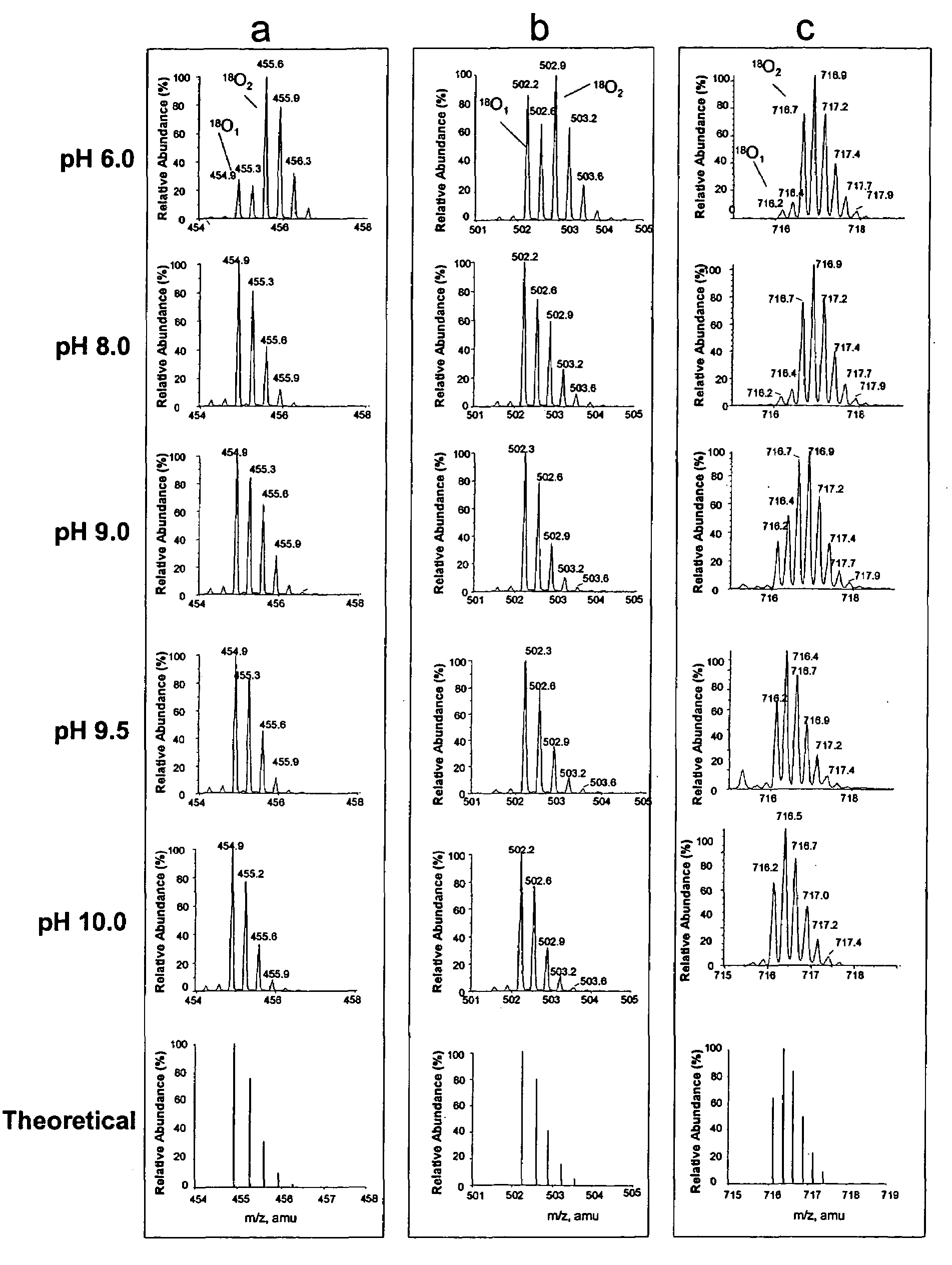Method for single oxygen atom incorporation into digested peptides using peptidases
a technology of peptidases and oxygen atoms, applied in the field of comparative proteomics, can solve the problems of inability to predict sub>2/sub>-peptides with any certainty, cumbersome 2d-gel running, poor dynamic range, etc., and achieve the effect of accurately quantifying different protein populations and highly accurate quantification methods for comparative proteomics
- Summary
- Abstract
- Description
- Claims
- Application Information
AI Technical Summary
Benefits of technology
Problems solved by technology
Method used
Image
Examples
example 1
Sample Preparation Prior to 18O Labeling of Proteolytic Peptides
[0033]The invention described herein employed a peptidase and 18O enriched water to preferentially label the C-terminal fragment of the digested peptides; however this invention is not limited to and includes water containing any stable oxygen isotope. All reagents are available and the chemistry is generally well-known to those skilled in the art. The following examples are illustrations of such technology that may be used.
[0034]The first step may or may not include a protein denaturation step. In the event that information is required about the protein or peptide conformational state or structure this step would be omitted. For example, for a protein or peptide that plays a role in signal transduction and undergoes a conformational change or modification due to an altered physiological condition would be within the scope of this invention to assess changes through altered accessibility to proteases.
[0035]In cases wher...
example 2
Methods of Stable Oxygen Isotope Labeling and LC / MS Analysis
[0037]Denatured proteins, reduced and carbamidomethylated if necessary, were digested using either Lys-N or Asp-N metalloendopeptidase. The conditions for the proteolytic digestion were standardized in our laboratory for the purpose of single labeled oxygen atom incorporation. Lys-N was obtained from Seikagaku Corp. (Tokyo, Japan). The digestion of proteins by Lys-N was performed in the following buffer systems; 100 mM sodium phosphate at pH 6.0 or 8.0 or 100 mM glycine-NaOH at pH 9.0, 9.5, or 10.0. The digestion buffers were prepared from their corresponding stock solutions by placing the required aliquot into Eppendorf tubes, drying with a Speed-Vac concentrator and reconstituting with the appropriate stable oxygen isotope, preferably H216O or enriched H218O. The digestions of proteins were incubated at 25° C. for 18 hrs using a Lys-N to substrate ratio of 1:85 (w / w), unless otherwise stated. The effective range of Lys-N ...
example 3
Optimizing Digestion Conditions for Single Oxygen Atom Incorporation
[0045]Apomyglobin was digested by Lys-N at pH 6.0, 8.0, 9.0, 9.5 or 10.0 using H218O prepared in 100 mM glycine-NaOH buffer. The resulting digests were analyzed by liquid chromatography-mass spectrometry (LC / MS). FIG. 1 shows the mass spectra of three representative apomyoglobin peptides that were hydrolyzed at different pH. In FIG. 1, panel a shows (M+3H)3+ ions of peptide KALELFRNDIAA (SEQ ID NO 1), panel b shows (M+3H)3+ ions of peptide KHPGDFGADAQGAMT (SEQ ID NO 2), and panel c shows (M+4H)4+ ions of peptide KVEADIAGHGQEVLIRLFTGHPETLE (SEQ ID NO 3). The bottom most spectrum in each panel is the theoretical abundances of the isotopes for each corresponding peptide containing one 18O atom. These results show that variability of the 18O1- and 18O2-peptide ratios is pH dependent. At pH 6.0, peptide peaks with two 18O atoms (18O2) were abundant in all the three peptides. As the pH is increased there is a steady decre...
PUM
| Property | Measurement | Unit |
|---|---|---|
| pH | aaaaa | aaaaa |
| pH | aaaaa | aaaaa |
| pH | aaaaa | aaaaa |
Abstract
Description
Claims
Application Information
 Login to View More
Login to View More - R&D
- Intellectual Property
- Life Sciences
- Materials
- Tech Scout
- Unparalleled Data Quality
- Higher Quality Content
- 60% Fewer Hallucinations
Browse by: Latest US Patents, China's latest patents, Technical Efficacy Thesaurus, Application Domain, Technology Topic, Popular Technical Reports.
© 2025 PatSnap. All rights reserved.Legal|Privacy policy|Modern Slavery Act Transparency Statement|Sitemap|About US| Contact US: help@patsnap.com



